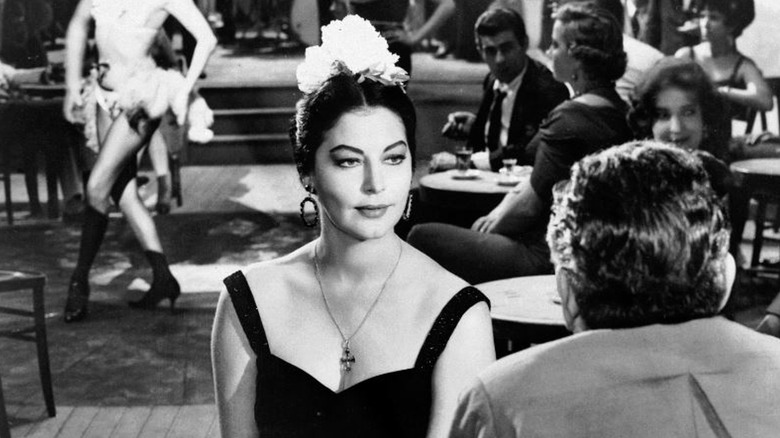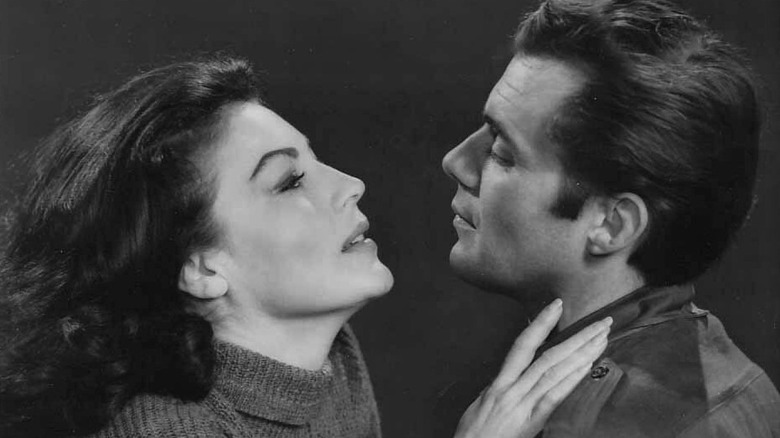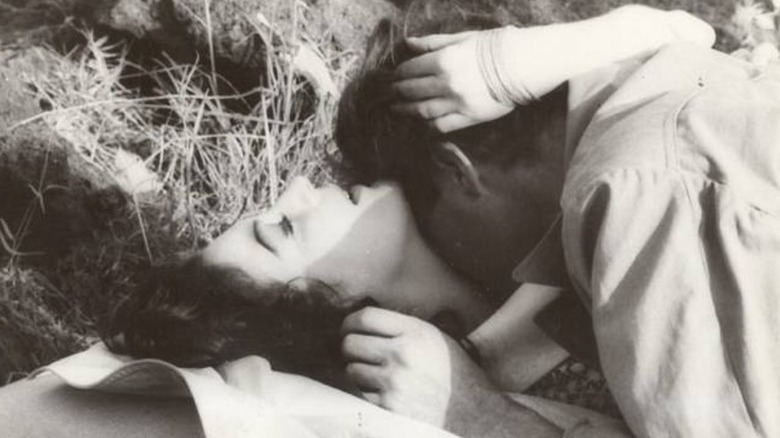Studio Demands Spelled Disaster For Ava Gardner On The Set Of The Angel Wore Red
Ava Gardner's career was a constant tug-of-war behind the scenes, and that was in large part due to her having to constantly maneuver around her home studio, Metro-Goldwyn-Mayer, aka MGM. In the golden age of Hollywood, the studio system wielded a ton of power, far more than the power imbalances we see with studios today. They shaped, sculpted, and launched the careers of many a favorite actor, director, screenwriter, etc. But there were strings attached that I'd liken to puppet strings. Bucking against those strings could get you cut.
In earlier roles, much criticism was directed towards Gardner for her supposed subpar acting abilities, abilities which MGM Studios failed to nurture in the young woman from the get-go. There was an emphasis on Gardner's image and, once roles in "Barefoot Contessa" and "The Killers" pigeonholed her in more seductive roles that emphasized her glamourous beauty, MGM really leaned into that image.
Unfortunately, this worked against Gardner time and time again. Looking back on it, we can see how MGM's influence over Gardner and her projects almost ended Gardner's career after the film "The Angel Wore Red." What started out as a promising shoot with a role that Gardner wholeheartedly embrace ended up going south once MGM stepped in. Their involvement and all the various changes they made during the shoot almost soured Gardner against the idea of working again. Micro-managing is the devil and MGM gave the devil its very wings with "The Angel Wore Red."
Hope springs eternal
Things weren't always so grim for "The Angel Wore Red." In fact, there was a lot of promise before launching into production. Seasoned screenwriter and director Nunnally Johnson was handling the film, and he had a string of successes under his belt. From "The Grapes of Wrath" to "The Man in the Grey Suit," Johnson knew his way around a script and could direct the socks out of people. With his inclusion alone, the film should have been a success.
Gardner herself was also reported to have been incredibly enthusiastic about taking on the role of Soledad. A woman in possession of vulnerability and giving some damsel in distress kind of vibes, this marked a slight turn for Gardner away from seductress roles. There was room for exploration in the country girl-turned-sex-worker role, where she could allow herself to step away from the glamourous image that had imprisoned her.
Unfortunately, MGM lacked courage with its projects. Gardner's co-star Dirk Bogarde recalled in Ava Gardner: A Life in Movies the experience, "We shot for vérité ... she wore no make-up, one awful old dress, it was good. After three weeks, MGM saw the first set of rushes, had hysterics, ordered the whole three weeks to be reshot with Ava dressed by Valentina, shoes by Ferragamo, makeup, ta ta ta ta. We all gave in and did as we were told and the film was a disaster." Financially and spiritually, the film flopped.
A studio behind the times
Two years prior, she had gotten out of her contract with MGM after making the lackluster "The Naked Maja," and had hoped that she wouldn't have to repeat these experiences again as a freelancer. In her autobiography, Ava: My Story, Gardner reflected, "'The Naked Maja' was the last picture I had to do on my damn MGM contract. When it was over, I was free at last — free to choose my own projects, free to command the kinds of fees I was worth. It was about time"
But she wasn't free in "The Angel Wore Red." MGM was desperately scrambling to capture the glory of the olden days before the federal government had slapped the big studios with an anti-trust lawsuit. Couple that with the audience's embrace of television and the rapidly changing climate of cinema entertainment, and their desperation and need to micro-manage ruined what could have been a strong film. Instead, it solidified for Gardner how much she hated working for MGM.
The period after "The Angel Wore Red" became a transitional one for Gardner. The experience on the film made her take a step away from taking on roles. But she did return and maintained that freelancer status for the remainder of her career. This gave her the ability to carefully curate her roles like her much-beloved take on Maxine Faulk in "The Night of the Iguana." If she had been a freelancer before, it's interesting to imagine what could have been.


